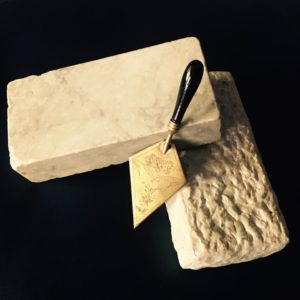Greetings from The West, Brethren;
I’ve got my mind on mortar and mortar on my mind right now. We are all taught the proper application of the trowel as speculative Masons, and are informed of its utility to our ancient operative Brothers; but today (and regrettably too often) I find illustrations depicting the operative use incorrectly; as a tool used to spread cement over the face of the work. To be clear: if your work needs to be smoothed over on its face – your work is slipshod and the weaknesses you’ve hidden will show in time. Indeed, there were times when our ancient Brethren did find it necessary to veneer their work, but Masonic tradition informs us that that most sublime Masonic edifice did not use tricks or shortcuts – the builders we study and revere took the longer, harder path of carefully selecting and preparing their stones; cementing them together by spreading their mortar between each and every one.
There is a great lesson in this – because mortar does more than cement and connect the work, unifying the structure; it protects the individual stones as well. There is direct, unrelenting pressure anywhere two stones touch. The slight, compounding and inevitable movements of the structure over time put further stress and friction upon the work. Direct contact between the stones puts all of them at risk; even if every facet of an ashlar is perfected and polished. And so that humble (but specifically formulated) blend of lime and gypsum softens their contact, just as it binds them intimately.
Perhaps you all know this already – it wouldn’t be the first time I was late to the game, but I think It’s good for all of us and our families; good for Friendship Lodge and friendship in general, to consider the proper application of the trowel, even one’s own ashlar is well-smoothed.
Fraternally,
Walter Lee
Senior Warden



